History
In 2010, a team of archaeologists (the Soprintendenza del Mare of Sicily and researchers from the RPM Nautical Foundation) pinpointed the exact location of the largest naval battle of antiquity—the so-called Battle of the Egadi Islands. Not only is it the largest, but it is also the only ancient naval battle site that has actually been rediscovered.
To the west of Sicily, 8 kilometres off the coast of the small island of Levanzo, the battle was fought in 241 BC between the Roman Republic and Carthage. This clash crippled the Carthaginian superpower and marked the beginning of Rome’s ascent to global dominance.
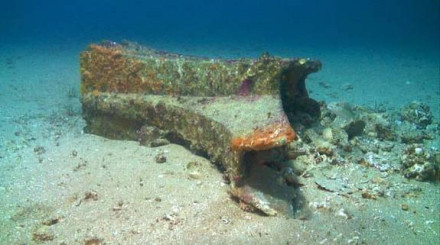
Site
The archaeological site covers a 10-square-kilometre sandy desert on the seabed, strewn with low rock formations at an average depth of 80 metres. The research sheds light on the construction of warships and the military material culture of classical antiquity.
Rams
In 2010, the first bronze ram (Greek: embolón, Latin: rostrum) belonging to a warship was found. As of 2025, a total of 27 rams have been recovered, both Roman and Carthaginian. Weighing approximately 125 kilograms each, the rams are made of bronze and were mounted on the prow of a galley just at the waterline. They were used to attack and ram enemy ships, serving as the main weapon of an ancient war galley.
Inscription
Several rams bear inscriptions in both Latin and Punic. On ram no. 25, there is an intriguing inscription:
Ser[vius] Solpicius C[aius] F[ili]. Quaestor Probavit,
transcription: Servius Sulpicius, quaestor, son of Gaius, approved it.
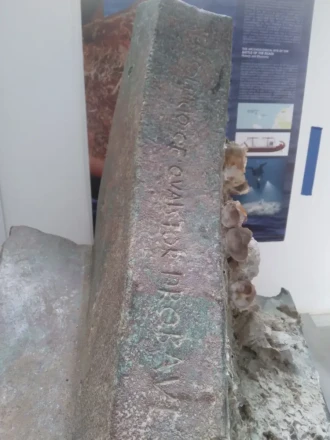
Ram 25 with Roman inscription
Servius Sulpicius was the son of Gaius Sulpicius. This name and individual are
historically recorded as a consul, one of the two highest magistrates of the Roman Republic. Gaius Sulpicius served as consul in 243 BC. He—and apparently his son as well—were closely involved in preparations for building the Roman fleet.
Anchors
In addition to the rams, 11 Roman lead anchors were found. The anchors were lying in a straight line on the seabed, suggesting that the ships were neatly moored in a row when they were surprised, with anchor ropes cut to set sail as quickly as possible.
Military Finds
Numerous other artefacts have been discovered, including lead sling bullets, (parts of) helmets, amphora shards, and more.
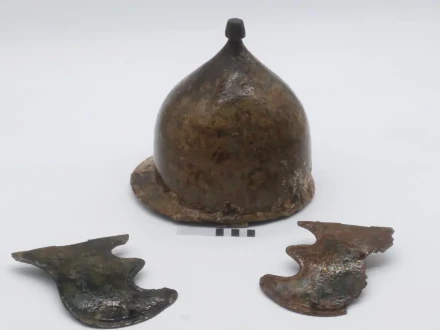
Montefortino Helmet
In the 2025 season, a perfectly intact Roman helmet was recovered—a Montefortino type helmet that was the standard in the Roman army from around 300 BC well into the 1st century AD. Yet, this is the first complete example ever excavated.
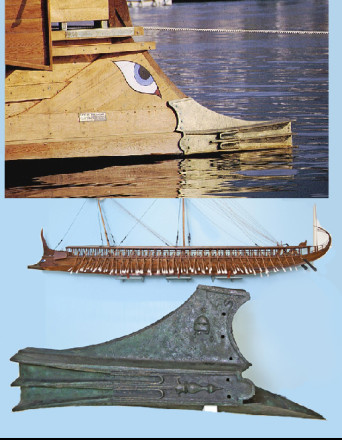
The First Punic War
It was this naval battle at the Egadi Islands that ended the First Punic War. The war began in 264 BC and was initially fought over dominance of Sicily. The two superpowers were well matched.
Ultimately, the conflict revolved around control of the western Mediterranean. Carthage, historically a maritime trading nation with bases in Sardinia, Sicily, Corsica, Spain, and North Africa, ruled the seas with its powerful fleet. At the outbreak of the war, the Roman Republic had just conquered all of Italy, but the Romans had no experience in naval warfare. They learned the craft by trial and error.
The Romans lost three major fleets during the war, partly due to disasters and partly in battles with Carthage. Naval supremacy seemed lost. The land campaign had also reached a stalemate. In a final effort to win the war, the Romans built a new fleet with the last funds from the treasury, while Carthage had neglected its fleet in the years leading up to the battle.
Early in 241, the Roman fleet, under Consul Gaius Lutatius, set sail and positioned itself just west of Sicily, between the city of Lilybaeum and the Egadi Islands. They expected the Carthaginian fleet, which was bringing supplies and reinforcements for its army on Sicily. The Carthaginian fleet did arrive, heavily loaded, and was taken by surprise by the strong Roman presence. The Punic fleet was completely unprepared to fight. The ships were too heavy to manoeuvre effectively, and the crews were inexperienced and untrained. In short, when the Romans attacked, the Carthaginian fleet was no match. Fifty ships were sunk, seventy—including their crews—were captured, and the rest fled. After this defeat, both sides made peace. Carthage lost all its overseas possessions and its status as a superpower to Rome. (Polybius, I, 60–62)
Rostra
The event was so significant that a monument was erected on the Forum in Rome, adorned with the rams from the captured Carthaginian ships. This ‘Rostra’ became the official speaking platform of the Roman state. The monument stood in front of the Senate building and was the centre of public life in Rome.
Marsala Wrecks
A little further south, near the city of Marsala (ancient Lilybaeum, Carthage's headquarters in Sicily), two Punic (war)ships from the same period were found. One of them is displayed in the nautical museum in Marsala (see: Marsala 1). Three different archaeological sites on the west coast of Sicily are linked to the same period and event: the First Punic War.
Puniers is the Roman term for Carthaginians. It is a corruption of Phoenicians. Carthage was originally a colony of the Phoenician city of Tyre (now in Lebanon).
Description
In the summer of 2010, a bronze ram (Latin: rostra) belonging to an ancient warship was found. It was the third in succession found in the waters off Levanzo island in western Sicily. The Egadi Islands Project has so far (April 2013) yielded a total of ten ancient bronze warship rams. The rams, each weighing around 125 kilograms, are made of bronze and would have been mounted on the prow of the warships (ancient triremes or quinquiremes). They were used to ram enemy ships.
Status
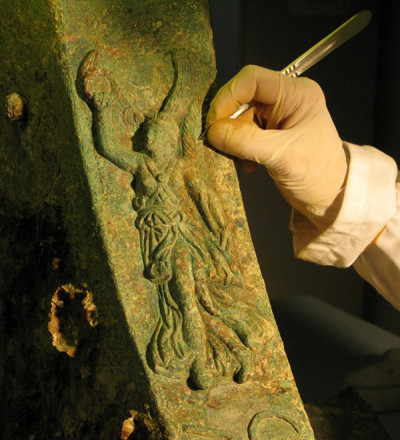
References
- regione.sicilia.
Nei fondali delle Egadi rinvenuti nuovi reperti tra cui un elmo "Montefortino". - RPM Nautical Foundation.
Ancient Naval Warfare Research Project, Battle of the Egadi Islands Project. - Polybius.
historia.